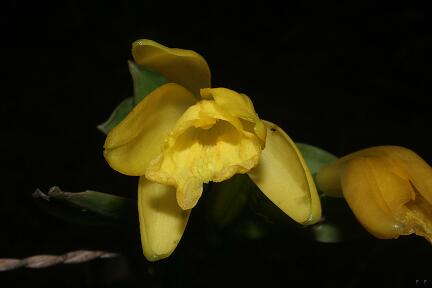Orchidaceae
Vanilla palmarum Lindl.

Kingdom: Plantae Rank: Species Parent: Vanilla Status: Valid
Vegetative Morphology
Habit: Obligate epiphyte on M. flexuosa, one to many-branched. Roots are of two varieties. Aerial roots produced from each node, short (less than 2 cm) and cup-like, reminiscent of a suction cup. Adventitious roots emerging from lower stems, long, thin, branched and extensive.
Main axis: Stems green, succulent, ca 0.5 cm in diameter, internodes ______ cm for climbing individuals.
Leaves: Leaves alternate, sessile, succulent, produced from each node opposite to roots, ca 3.2 x 7 cm – 5.5 x 16 cm. When with terminal raceme forms a long shoot with diminishing leaf size and internodes; blade lanceolate, apex acute, margin entire, texture smooth, color light green.
Reproductive Morphology
Inflorescence: Inflorescences racemose, mostly terminal, fleshy, green, ca. 5 to 15-flowered; bracts vary in size, basally located bracts often large to 3cm in length, shape oval with acute to acuminate apices, non-floriferous bracts 2 to 4, bracts located apically smaller.
Flowers: Flowers resupinate, tender, fleshy, arranged spirally, flowers lightly fragrant, remaining attached to ovary if successfully pollinated; pedicel green, but somewhat whitish at extreme base, with ovary; buds green; dorsal sepal yellow, elliptic, ca 1.2 x 6cm, apex acute; lateral sepals yellow, ca 1.3 x 5.6 cm, asymmetrical with bend beginning 2.5 cm from base; petals yellow, elliptic, apex acute, longitudinally ribbed on dorsal surface, ca 1.6 x 5.5 cm; lip uniformly yellow, flabellate when flattened, shallowly caniculate, conspicuous swollen tissue oriented longitudinally at mouth; callus absent; column hirsute on ventral surface near rostrellum, ca. 4 cm long, 0.25 cm wide, slightly curved; rostrellum thin, yellow.
Fruit: Fruit capsule splitting longitudinally in two unequal valves, triangular cross-section, succulent and green when immature, ca. 12 cm long, quickly drying upon dehiscence, non-fragrant.
Other
Distribution:
V. palmerum is widespread in Madre de Dios, occurring in the small but ubiquitous M. flexuosa-dominated wetlands characterized by hydromorphic substrates with a high mineral component. The species has been observed in wide (approximately 200 m) spring-fed streams with sandy bottoms, on unconsolidated clays on the edges of sping-fed blackwater lakes, and in rain-fed depressions on gleysols. In all cases M. flexuosa was monodominant. Similar to V. bicolor, the vining herbs are epiphytic in M. flexuosa crowns, sending long, slender, highly branched roots deep into the sheathing petioles. Although restricted to the same host, V. palmerum and V. bicolor never occur in mixed populations, the latter restricted to M. flexousa wetlands with permanently flooded histosols.
This species is also known from the Guianas where it also grows in the crowns of the palm genus Mauritia. It is also reported to occur commonly in northeastern Brazil and in Mato Grosso, Brazil, where is grows on Syagarus coronata (Arecaceae), a common arborescent palm of drier ‘cerrado’ formations (Toscano de Brito, pers com).
Ecology: Flowers open singly on the racemes at intervals of three to four days. Flowering phenology is bimodal, with peaks in Jan/Feb and Oct/Nov. The flowers are slightly fragrant but no pollinators have been observed near flowers. Pollination rates are high at 76%, apparently resulting from self-pollination (Table 1). Despite a seemingly more effective barrier provided by the thick rostrellum the mechanism of self-pollination seems to be identical to that of V. bicolor. Excessive stigmatic fluids induce pollen grains to leak onto the extreme lateral margins of the stigmatic surface. Pollination rates of flowers located basally on racemes are significantly higher than flowers located apically. This may indicate a degree of control of the self-pollination mechanism, perhaps induced by high resource requirements of fruit maturation and mediated by the allocation of limited resources to competing vegetative and reproductive needs (Chiariello and Gulman 1991). The fruits are non-fragrant and dry within several days. Seedlings are abundant in the canopies of M. flexuosa palms as in V. bicolor. Reproductive adults high in the canopy probably seed the very specialized germination microsites through combination of wind turbulence and gravity.
Notes: Vanilla palmerum is a basal member of the American clade of fragrant Vanilla, and sister species to V. bicolor.